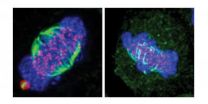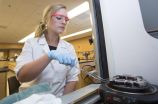(Press-News.org) MADISON -- Mike Graham knows that fluid dynamics can reveal much about how the flow of blood helps and hinders individual blood cells as they go about their work.
Graham, the Vilas Distinguished Achievement Professor and Harvey D. Spangler Professor of Chemical and Biological Engineering at UW-Madison, established a theoretical basis for these ideas by creating complex computer stimulations that show how relatively stiff white blood cells and platelets interact with more flexible red blood cells. As the different cells collide during blood flow, white cells tend to be pushed toward the walls of a blood vessel. This segregation process, called margination, creates some advantages--for example, letting white blood cells quickly exit the blood vessel to head to the site of an injury or infection.
However, the mechanical details of blood could spell both good news and bad in areas ranging from drug delivery to blood disorders to the spread of disease. "I view my role as providing a fundamental basis of understanding for practitioners and for other engineers who are more directly connected with applications," Graham says.
Graham's work has reached a crucial turning point, yielding a theory that opens a door for other researchers to take advantage of what Graham's group has learned and observed throughout years of computationally simulating the physics of blood flow. In a paper published May 1, 2015, in the journal Physical Review Letters, Graham and PhD students Kushal Sinha and Rafael G. Henríquez Rivera lay out an equation that yields simple predictions as to how quickly blood cells will migrate away from blood-vessel walls, how they will behave when they collide with each other and accordingly how they will segregate during flow.
In the long run, these insights could help practitioners manipulate the mechanics of blood to design better blood-transfusion treatments, craft techniques for delivering drugs through small particles in the blood, and perhaps even devise processes for isolating blood-borne tumor cells that spread cancer throughout the body.
"I'm really excited about this paper, because it's the first analytical theory for this phenomenon," Graham says. "It's not very common that theory is ahead of experiments, but we're in that position now."
That said, Graham is proceeding on both fronts to draw a firmer connection between these mechanical insights and the many biological functions they might impact. Moving ahead, his group will both refine the new equation to suit more complex flow situations and pursue an experimental collaboration with Wilbur Lam, a hematologist at Georgia Tech and Emory University in Atlanta.
Building on Graham's theoretical and simulation work, Lam's research group is creating microfluidic devices to study the behavior of blood cells in essentially their natural habitat. Lam has developed a way to grow endothelial cells -- which line the interior walls of our blood vessels -- inside the artificial channels of the microfluidic devices. "I think together our labs have really stumbled on how fluid mechanics may be able to explain a lot of the biological phenomena we see in blood," Lam says. "This can be related to a new way of understanding inflammation, infections, even transfusion medicine. It really pervades many different problems we see in hematology."
Even in developing the computational and theoretical side of the work, Graham thinks a great deal about making sure his work is credible to medical practitioners. That is especially challenging for a researcher who deals in computer simulations, because a simulation simply can't factor in every single variable without requiring a prohibitive amount of computing resources.
However, Graham says that capturing the physical nuances of blood vessels' shape, size and relative stiffness has tremendous value, even given the myriad other forces at work in the human body.
"We'd like to be able to convince practitioners that you don't have to worry about all the details to capture the fundamental understanding of what's going on," Graham says. "It's extremely challenging to incorporate all the phenomena that might be important into a simulation. You have to make your case convincingly, if you want somebody to apply this research, that you've kept the important parts."
Both researchers point out that sickle cell anemia has long been understood as both a mechanical and a biological problem. The defective red blood cells the disease causes are not only misshapen, but also stiffer than healthy red blood cells, meaning they block blood flow. Yet on a more detailed mechanical level, Graham and Lam say, it may even be that sickle cells literally poke and irritate the inner walls of blood vessels. If so, that would make sickle cell anemia not just a blood disorder but a disorder of the entire circulatory system. Their combined research strengths now create an opportunity to test that hypothesis. "Biologists and hematologists have known for decades that these cells can get stuck, but what is less understood is that the blood vessel walls in the entire patient are really inflamed, and we don't really know why," Lam says.
The researchers say a better understanding of blood-flow mechanics also could help to make blood transfusions safer. Transfusions can sometimes set off heart attacks or lung damage, and the medical community isn't entirely sure why. Lam wants to find out if certain cells in stored donated blood have mechanical properties that put patients at greater risk.
Though his collaboration with Lam is still in an early stage, both researchers see the possibility of opening a new frontier in blood research.
"This would be a whole new category of things we could be looking at, and that's why it's so exciting," Lam says. "Suddenly we have applications where the mechanics can be just as important."
INFORMATION:
Graham's blood research is supported by a $356,770 grant from the National Science Foundation.
--Scott Gordon, (608) 265-8592, gordon@engr.wisc.edu
Volcanoes are considered chaotic systems. They are difficult to model because the geophysical and chemical parameters in volcanic eruptions exhibit high levels of uncertainty. Now, Dmitri V. Alexandrov and colleagues from the Ural Federal University in Ekaterinburg, in the Russian Federation, have further extended an eruption model -- previously developed by other scientists -- to the friction force at work between the volcanic plug and volcanic conduit surface. The results, published in EPJ B, provide evidence that volcanic activity can be induced by external noises that ...
Chinese scientists have reared beef rich in the beneficial fatty acids associated with fish oils. The study in Springer's journal Biotechnology Letters also highlights the scientific challenges that remain.
The team from Northwest A&F University and the National Beef Cattle Improvement Centre, both in Yangling (Shaanxi), successfully introduced a gene into foetal cells from Luxi Yellow cattle, a Chinese breed with a high beef yield. The fat1 gene, isolated from a nematode worm, codes for desaturase enzymes that are involved in the conversion of n-6 to n-3 polyunsaturated ...
How much food your dining companion eats can have a big influence on how much you consume, a UNSW Australia-led study concludes.
This psychological effect, known as social modelling, leads people to eat less than they normally would if alone when their companion consumes a small amount of food.
Study lead author, Associate Professor Lenny Vartanian of the UNSW School of Psychology, says that in social situations the appropriate amount of food to eat can be unclear.
"Internal signals like hunger and feeling full can often be unreliable guides. In these situations people ...
An international consortium of scientists led by a group from the University of Leicester has announced a new advance in understanding the mechanisms of cancer and how to target it more effectively with new treatments.
Two papers published in the same issue of the world-leading Journal of Cell Biology have arisen from research work led by Professor Andrew Fry at the University of Leicester. Both papers suggest that new understanding of the mechanics of cell division can reveal new targets for cancer therapy.
Professor Fry, who is Director of Research in the College ...
Geoscientists have, for the first time, discovered the origins of Australia's two largest basins: Lake Eyre and the Murray-Darling Basin. The research also implies that in 30 million years' time both basins will cease to exist.
Monash University geoscientist Associate Professor Wouter Schellart, and his colleague Professor Wim Spakman from Utrecht University, have discovered how the floor of an entire ocean basin that was destroyed 70 to 50 million years ago off the North coast of New Guinea is currently located at 800-1200km depth below Central and South-eastern Australia.
Using ...
New scanning methods which map the wiring of the brain could provide a valuable new tool to predict people at risk of schizophrenia, according to a new study.
Scientists have long known that the symptoms of schizophrenia are partly explained by disordered connectivity in the brain.
Now, a team of scientists from Cardiff University Brain Research Imaging Centre (CUBRIC), the Institute of Psychiatry, Psychology and Neuroscience, Kings College London and the University of Bristol, have, for the first time, used Magnetic Resonance Imaging (MRI) to identify how the ...
Myopia or short-sightedness is becoming more common across Europe, according to a new study led by King's College London. The meta-analysis of findings from 15 studies by the European Eye Epidemiology Consortium found that around a quarter of the European population is short-sighted but it is nearly twice as common in younger people, with almost half (47 per cent) of the group aged between 25 and 29 years affected.
The analysis of studies covering over 60,000 people, which was published today in the journal Ophthalmology, also found a strong link between myopia and level ...
New research suggests the use of hookah steam stones - commonly considered a safer alternative to cigarette smoking - could be leaving users with a dangerous, false sense of security. The findings out of the University of Cincinnati/Agilent Technologies Metallomics Center of the Americas are published this month in the Microchemical Journal.
An analysis led by Amberlie Clutterbuck, a doctoral student in the UC Department of Chemistry, found residues of toxic metals that included chromium, arsenic and cadmium following several simulated hookah/steam stones smoking scenarios.
Clutterbuck's ...
Philadelphia, PA, May 11, 2015 -- Dopamine is the chemical messenger in the brain most closely associated with pleasure and reward. Recent scientific advances now shed light on precise roles for dopamine in the reward process.
A new paper published in the current issue of Biological Psychiatry implicates dopamine in a person's ability to be motivated by delayed rewards.
People like immediate reinforcement and tend to devalue rewards that are substantially delayed in time. As a result, people will often opt for smaller immediate rewards as opposed to larger delayed rewards ...
Even with the best available treatments, the median survival of patients with metastatic, hormone-refractory prostate cancer is only two to three years. Driven by the need for more effective therapies for these patients, researchers at VCU Massey Cancer Center and the VCU Institute of Molecular Medicine (VIMM) have developed a unique approach that uses microscopic gas bubbles to deliver directly to the cancer a viral gene therapy in combination with an experimental drug that targets a specific gene driving the cancer's growth.
Recently published in the journal Oncotarget, ...


